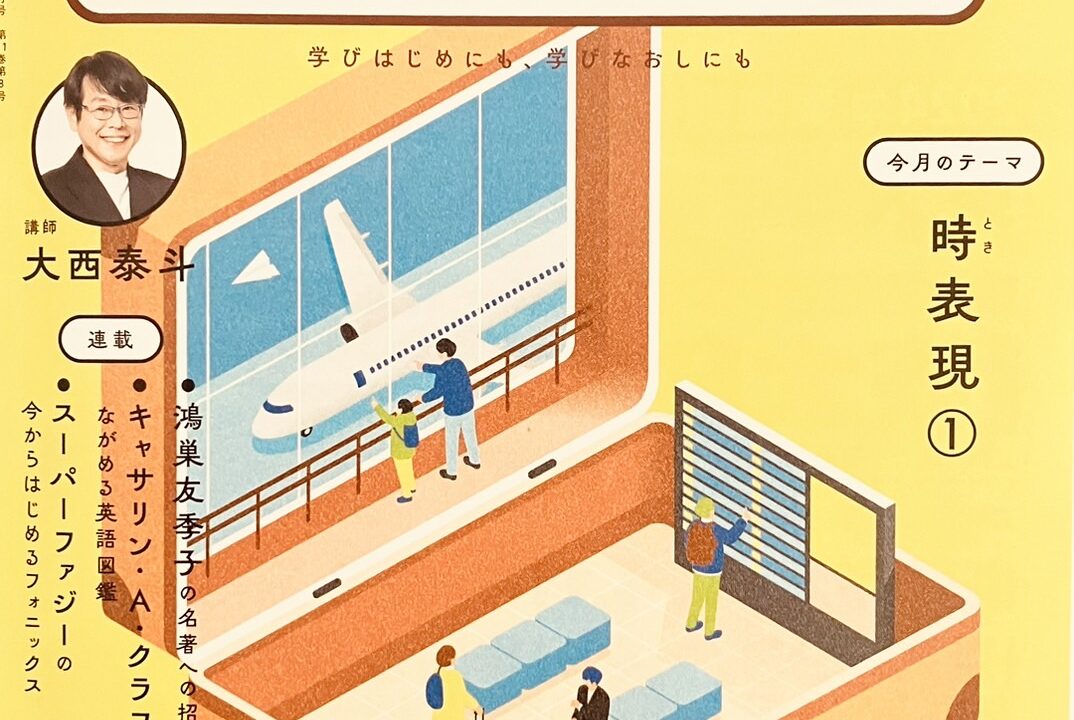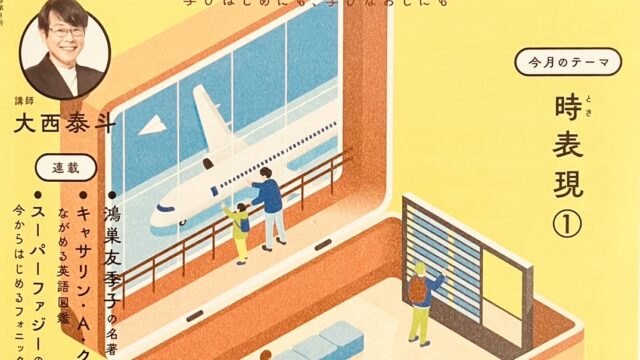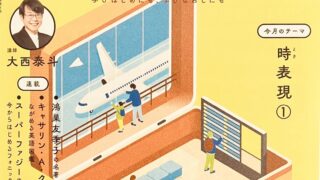【ラジオ英会話】Lesson 148 現在形④未来を表す副詞節 – November 13 Wednesday, 2024

November 13 Wednesday, 2024
Lesson 148 現在形④未来を表す副詞節
★Opening
D: And I’m David Evans. Sometimes his humor lacks originality.
☆Words & Phrases
**baggage claim:
I’ve just left the gate. I’m walking to the baggage claim.
**bump:
How was the flight? – It was fine. We had a few bumps near Alaska, but it wasn’t too bad.
**pick ~ up:
Thanks again for coming to pick me up.
Drive safely, Kelly. – I will.
☆Grammar and Vocabulary
It was fine.
fine のイメージ
「濁りがない・スッキリしている」ということ。このイメージがここでは「問題ない」に結びついている。
How are you? と尋ねられたときの I’m fine. も「体調・精神的に問題がない」ということ。
「晴れ」の意味で使われるときも「(雲などによって空が)濁っていない」ということ。
Good to hear.
説明ルール
「説明ルール: 説明は後ろに置く」は、非常に一般的な修飾規則。
この文でも、Good(よかった)という感情の説明が(to hear [それを] 聞いて)となって いる。

☆Target Forms
I’ll call you again when I arrive at the airport.
「未来を表す副詞節では(未来表現は使わず)現在形を用いる」という現象
when I arrive at the airport(空港に着いたら)は、I’ll call you again を説明する副詞節
厳密に言えばこれから起こることを述べているが、使われている動詞は arrive と現在形
それは「空港に着く」が「前提」になっているため
それが起こっていると見なしているため現在形が使われている
will や be going to など未来表現が使われないのも「空港に到着するだろう」といった推測の意味が含まれないため
副詞節:名詞以外を修飾する要素を「副詞」と呼ぶ。when 以下は「文」を修飾するので「副詞」で、節の形式を持つため「副詞節」
Practice
when 以下を「起こっている」と見なして現在形を用いるのがポイントです。
when I arrive at the airport
↓
I’ll call you again when I arrive at the airport.
① I’ll let you know as soon as I arrive.
→ as soon as ~ は「~するとすぐ」
「到着したらすぐ」と到着が前提となっているので arrive は現在形
② Ask me before you use my stuff.
Please tidy up after you eat.
**tidy up:
→ before, after の後ろの節も「前提」なので現在形
③ I’ll call you as soon as I’ve done my homework.
→「前提」には現在完了形も使われる。その状況が「完了」したことが前提となっている
ここでは「宿題を終えた(らすぐに)」ということ
★Practice
D: All right everyone. It’s time for today’s practice. We’ll be using「副詞節」today. These「副詞節」will give more information about when something should happen. Okay?
R: Let’s begin practicing,
– as soon as I arrive, as soon as I arrive
– I’ll let you know as soon as I arrive.
D: All right. Let’s keep going,
– before you use my stuff, before you use my stuff
– Ask me before you use my stuff.
– after you eat, after you eat
– Please tidy up after you eat.
R: Okay. And one more,
– as soon as I’ve done my homework, as soon as I’ve done my homework
– I’ll call you as soon as I’ve done my homework.
D: Unlock your potential.
R: Repetition is the key!
D&R: Great work.
☆Grammar in Action
①水が沸騰したらパスタを加えてください。その前に加えないように。
**boil:
②タイマーが鳴ったらすぐにオーブンを切って。ケーキを焦がしたくはありませんよね。
**go off:
③手を洗ったらこれらのニンジンをむくのを手伝って。
**peel:
★Ending
R: After you finish this program, be sure to keep on practicing.
D: That’s right. Don’t forget to review…
November 13 Wednesday, 2024
Lesson 148 現在形④未来を表す副詞節
(日本語訳・解説付き)
★Opening
D: And I’m David Evans. Sometimes his humor lacks originality.
☆Words & Phrases
**baggage claim:(空港などの)手荷物受取所
I’ve just left the gate. I’m walking to the baggage claim.
今、ゲートを出たばかりなんだ。手荷物受取所に向かって歩いているところだよ。
**bump:(乱気流などによる)航空機の揺れ
How was the flight? – It was fine. We had a few bumps near Alaska, but it wasn’t too bad.
空の旅はどうだった? – 問題はなかったよ。アラスカの近くでちょっと揺れたけれど、そんなにひどくはなかった。
**pick ~ up: ~を車で迎えに来る
Thanks again for coming to pick me up.
車で迎えに来てくれるんだね、ありがとう。
Drive safely, Kelly. – I will.
安全運転でね、ケリー。- もちろんよ。
※Drive safely. – I will. は覚えて使いたいやり取りです!
☆Grammar and Vocabulary
It was fine.
問題はありませんでした。
fine のイメージ
「濁りがない・スッキリしている」ということ。このイメージがここでは「問題ない」に結びついている。
How are you? と尋ねられたときの I’m fine. も「体調・精神的に問題がない」ということ。
「晴れ」の意味で使われるときも「(雲などによって空が)濁っていない」ということ。
Good to hear.
それはよかった。
説明ルール
「説明ルール: 説明は後ろに置く」は、非常に一般的な修飾規則。
この文でも、Good(よかった)という感情の説明が(to hear [それを] 聞いて)となって いる。

☆Target Forms
I’ll call you again when I arrive at the airport.
空港に着いたらまたあなたに電話をしますね。
「未来を表す副詞節では(未来表現は使わず)現在形を用いる」という現象
when I arrive at the airport(空港に着いたら)は、I’ll call you again を説明する副詞節
厳密に言えばこれから起こることを述べているが、使われている動詞は arrive と現在形
それは「空港に着く」が「前提」になっているため
それが起こっていると見なしているため現在形が使われている
will や be going to など未来表現が使われないのも「空港に到着するだろう」といった推測の意味が含まれないため
副詞節:名詞以外を修飾する要素を「副詞」と呼ぶ。when 以下は「文」を修飾するので「副詞」で、節の形式を持つため「副詞節」
Practice
when 以下を「起こっている」と見なして現在形を用いるのがポイントです。
when I arrive at the airport
↓
I’ll call you again when I arrive at the airport.
① I’ll let you know as soon as I arrive.
到着したらすぐに連絡しますね。
→ as soon as ~ は「~するとすぐ」
「到着したらすぐ」と到着が前提となっているので arrive は現在形
② Ask me before you use my stuff.
私のものを使う前に私に聞いてくださいね。
Please tidy up after you eat.
食べたあとはきれいに片づけてくださいね。
**tidy up: きれいに片付ける
→ before, after の後ろの節も「前提」なので現在形
③ I’ll call you as soon as I’ve done my homework.
宿題が終わったらすぐにあなたに電話しますね。
→「前提」には現在完了形も使われる。その状況が「完了」したことが前提となっている
ここでは「宿題を終えた(らすぐに)」ということ
★Practice
D: All right everyone. It’s time for today’s practice. We’ll be using「副詞節」today. These「副詞節」will give more information about when something should happen. Okay?
R: Let’s begin practicing,
– as soon as I arrive, as soon as I arrive
– I’ll let you know as soon as I arrive.
D: All right. Let’s keep going,
– before you use my stuff, before you use my stuff
– Ask me before you use my stuff.
– after you eat, after you eat
– Please tidy up after you eat.
R: Okay. And one more,
– as soon as I’ve done my homework, as soon as I’ve done my homework
– I’ll call you as soon as I’ve done my homework.
D: Unlock your potential.
R: Repetition is the key!
D&R: Great work.
☆Grammar in Action
①水が沸騰したらパスタを加えてください。その前に加えないように。
Add the pasta when the water boils. Don’t add it before that.
**boil: 沸騰する
②タイマーが鳴ったらすぐにオーブンを切って。ケーキを焦がしたくはありませんよね。
Turn off the oven as soon as the timer goes off. You don’t want to burn the cake.
**go off:(アラームなどが)鳴る
③手を洗ったらこれらのニンジンをむくのを手伝って。
After you’ve washed your hands, help me peel these carrots.
※help 以下は目的語説明型(SVOC)「me が peel these carrots するのを help(手伝う)」
**peel: 剥く
★Ending
R: After you finish this program, be sure to keep on practicing.
このプログラムが終わったら、必ず練習を続けてね。
D: That’s right. Don’t forget to review…
そう。復習も忘れないようにね。
名古屋駅前【AI×英会話】名古屋BEGビジネス英会話ジム – AIで鍛えるビジネスで使える英語力。仕事も日常も、一歩先へ。
営業時間:平日 9:00~22:00 土曜日 9:00~19:00(日祝休み)
〒450-0002 愛知県名古屋市中村区名駅2丁目40-16 名駅野村ビル 5階



